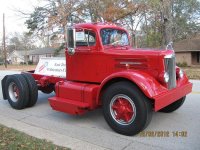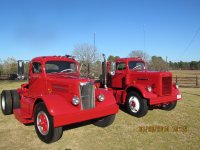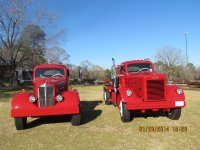Assuming they're both 4-speeds, if the axle is working you can start that one off in 2nd on the road as long as the axle is in low. If the axle's not working or you don't want to take a chance with it you can probably always start out in 1st gear and be OK. If it were me I wouldn't get into split-shifting old stuff like that, why take a chance on busting something or getting hung up between gears like others have mentioned. If the 2-speed works OK, just start off in low range, run thru the tranny gears, and once in top gear on the highway shift the axle into high using the clutch, like using an overdrive; why look for trouble on a nice old truck. If you want to practice downshifting the axle, first try going from high to low without shifting the tranny at the same time; downshifting the axle takes more skill than upshifting and can be harder on the axle if done wrong or something is not working right.




